Nu 6 maanden 50% korting
Meer dan 1 miljoen luisterboeken en ebooks in één app. Ontdek Storytel nu.
- Unieke aanbieding: start nu vanaf €4,99
- Switch makkelijk tussen luisteren en lezen
- Elke week honderden nieuwe verhalen
- Voor ieder een passend abonnement
- Opzeggen wanneer je maar wilt

The Architecture of Suspense: The Built World in the Films of Alfred Hitchcock
- Door
- Uitgever
- Serie
1 of 7
- Taal
- Engels
- Format
- Categorie
Geschiedenis
The inimitable, haunting films of Alfred Hitchcock took place in settings, both exterior and interior, that deeply impacted our experiences of his most unforgettable works. From the enclosed spaces of Rope and Rear Window to the wide-open expanses of North by Northwest, the physical worlds inhabited by desperate characters are a crucial element in our perception of the Hitchcockian universe. As Christine Madrid French reveals in this original and indispensable book, Hitchcock’s relation to the built world was informed by an intense engagement with location and architectural form—in an era marked by modernism’s advance—fueled by some of the most creative midcentury designers in film.
Hitchcock saw elements of the built world not just as scenic devices but as interactive areas to frame narrative exchanges. In his films, building forms also serve a sentient purpose—to capture and convey feelings, sensations, and moments that generate an emotive response from the viewer. Visualizing the contemporary built landscape allowed the director to illuminate Americans’ everyday experiences as well as their own uncertain relationship with their environment and with each other.
French shares several untold stories, such as the real-life suicide outside the Hotel Empire in Vertigo (which foreshadowed uncannily that film’s tragic finale), and takes us to the actual buildings that served as the inspiration for Psycho’s infamous Bates Motel. Her analysis of North by Northwest uncovers the Frank Lloyd Wright underpinnings for Robert Boyle’s design of the modernist house from the film’s celebrated Mount Rushmore sequence and ingeniously establishes the Vandamm House as the prototype of the cinematic trope of the villain’s lair. She also shows how the widespread unemployment of the 1930s resulted in a surge of gifted architects transplanting their careers into the film industry. These practitioners created sets that drew from contemporary design schools of thought and referenced real structures, both modern and historic. The Architecture of Suspense is the first book to document how these great architectural minds found expression in Hitchcock’s films and how the director used their talents and his own unique vision to create an enduring and evocative cinematic world.
Publication of this volume was assisted by a grant from Furthermore: a program of the J. M. Kaplan Fund
© 2022 University of Virginia Press (Ebook): 9780813947686
Publicatiedatum
Ebook: 8 september 2022
Anderen genoten ook van...
- Hyperion, Or the Hermit in Greece - Hölderlin Friedrich Hölderlin
- Once Upon a Time in Hollywood: A Novel Quentin Tarantino
- Atop an Underwood: Early Stories and Other Writings Jack Kerouac
- The American Bible: How Our Words Unite, Divide, and Define a Nation Stephen Prothero
- The Top 10 Short Stories - The German Language Franz Kafka
- Twelfth Night William Shakespeare
- Deadly Nightshade Cynthia Riggs
- Marie Curie Kathleen Krull
- Ideas Edmund Husserl
- The Adventures of Tom Sawyer Mark Twain
- Ardèche Linda van Rijn
3.5
- Longeneeslijk: Hoe mijn kanker pure pech én puur geluk kon zijn Hanneke Mijnster
4.7
- De Camino Anya Niewierra
4.6
- Slaapmeditatie: 30 minuten meditatie voor ontspanning en slaap Meike Meinhardt
4.2
- Het eetcafé op de hoek Aline van Wijnen
4.3
- De domheid regeert: Hoe opzettelijke onwetendheid een politieke strategie werd Sander Schimmelpenninck
4.3
- Mama huilt harder: Twee kinderen, twee depressies Leslie Keijzer
4.6
- Harry Potter and the Philosopher's Stone J.K. Rowling
4.7
- Het wordt ook steeds gekker: Het leven van een politieagent Lieke Hester
4.6
- Groeipijn: Achter je liggen de lessen en voor je de kansen Ray Klaassens
4.7
- Afl. 1 - Het dubbelleven van Rose Milou Deelen
3.2
- De nomade Anya Niewierra
4.6
- Harry Potter and the Chamber of Secrets J.K. Rowling
4.8
- B&B Toscane - Geheim verleden Suzanne Vermeer
3.8
- Ik ben vrij Lale Gül
4.7
Maak je keuze:
Voor ieder een passend abonnement
Kies het aantal uur en accounts dat bij jou past
Download verhalen voor offline toegang
Kids Mode - een veilige omgeving voor kinderen
Unlimited
Voor wie onbeperkt wil luisteren en lezen.
1 account
Onbeperkte toegang
Meer dan 1 miljoen luisterboeken en ebooks
Altijd opzegbaar
Premium
Voor wie zo nu en dan wil luisteren en lezen.
1 account
30 uur/30 dagen
Meer dan 1 miljoen luisterboeken en ebooks
Altijd opzegbaar
Flex
Voor wie Storytel wil proberen.
1 account
10 uur/30 dagen
Spaar ongebruikte uren op tot 50 uur
Meer dan 1 miljoen luisterboeken en ebooks
Altijd opzegbaar
Family
Voor wie verhalen met familie en vrienden wil delen.
2-3 accounts
Onbeperkte toegang
Meer dan 1 miljoen luisterboeken en ebooks
Altijd opzegbaar
2 accounts
€18.99 /30 dagenNederlands
Nederland